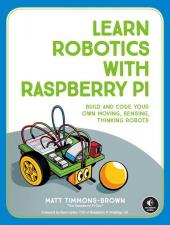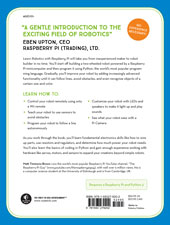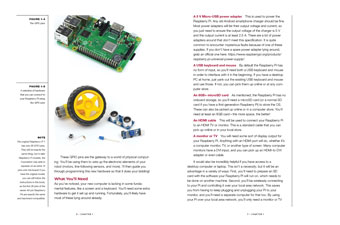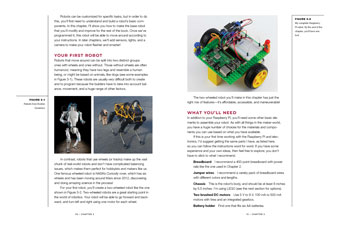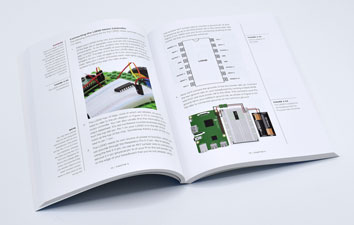Introduction
Chapter 1: Getting Up and Running
Chapter 2: Electronics Basics
Chapter 3: Building Your Robot
Chapter 4: Making Your Robot Move
Chapter 5: Obstacle Avoidance
Chapter 6: Adding RGB LEDs and Sound
Chapter 7: Line Following
Chapter 8: Computer Vision: Follow a Colored Ball
Appendix A: Next Steps
Appendix B: Raspberry Pi GPIO Diagram
Appendix C: Resistor Guide
Appendix D: How to Solder
Appendix E: Run Program on Startup
Learn Robotics with Raspberry Pi
Look Inside!
Check out author Matt Timmons-Brown's feature in Wired.
Reviewed in iProgrammer, The Midwest Book Review, and ElectronicsWeekly.com.
"This book really is an excellent introduction to Raspberry Pi robotics …[i]t is well-written and very accurate…[and] is stunning to look at…."
—Michael Horne, Raspberry Pi Pod
"Learn Robotics with Raspberry Pi is a great book for a makerspace or school looking to dabble in robotics and electronics but have no idea where to start."
—Les Pounder, Electromaker
"Learn Robotics with Raspberry Pi is a great above-basic level introduction to building a standard robot and learning a bit about the Linux operating system, Python programming, and some basic electronics."
—Greg Laden, Greg Laden's Blog
Download Chapter 4: Making Your Robot Move
Click here to download the code and resources from GitHub
Learn Robotics with Raspberry Pi will take you from inexperienced maker to robot builder. You’ll start off building a two-wheeled robot powered by a Raspberry Pi minicomputer and then program it using Python, the world’s most popular programming language. Gradually, you’ll improve your robot by adding increasingly advanced functionality until it can follow lines, avoid obstacles, and even recognize objects of a certain size and color using computer vision.
Learn how to:
- Control your robot remotely using only a Wii remote
- Teach your robot to use sensors to avoid obstacles
- Program your robot to follow a line autonomously
- Customize your robot with LEDs and speakers to make it light up and play sounds
- See what your robot sees with a Pi Camera
As you work through the book, you’ll learn fundamental electronics skills like how to wire up parts, use resistors and regulators, and determine how much power your robot needs. By the end, you’ll have learned the basics of coding in Python and know enough about working with hardware like LEDs, motors, and sensors to expand your creations beyond simple robots.
Requirements: Raspberry Pi and Python 3. Compatible with all Raspberry Pi models. Model 3A+/3B+ or Zero W recommended.
Check out this preview of the projects in Learn Robotics with Raspberry Pi!
Check out author Matt Timmons-Brown's feature in Wired.
Reviewed in iProgrammer, The Midwest Book Review, and ElectronicsWeekly.com.
"This book really is an excellent introduction to Raspberry Pi robotics …[i]t is well-written and very accurate…[and] is stunning to look at…."
—Michael Horne, Raspberry Pi Pod
"Learn Robotics with Raspberry Pi is a great book for a makerspace or school looking to dabble in robotics and electronics but have no idea where to start."
—Les Pounder, Electromaker
"Learn Robotics with Raspberry Pi is a great above-basic level introduction to building a standard robot and learning a bit about the Linux operating system, Python programming, and some basic electronics."
—Greg Laden, Greg Laden's Blog



